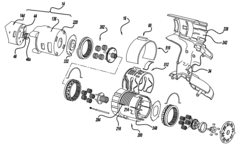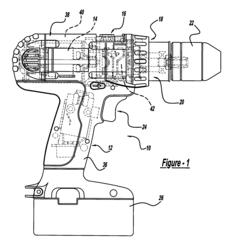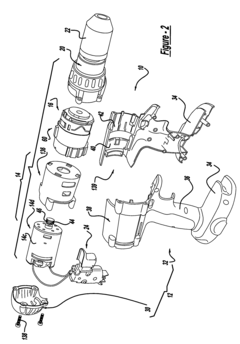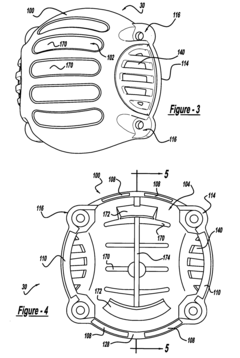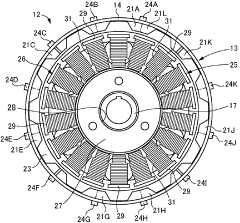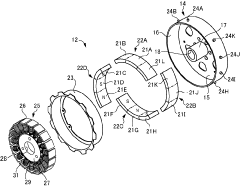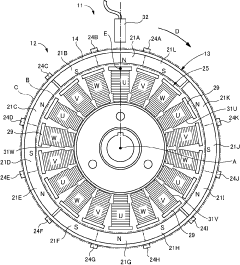A Comprehensive Guide to K24 Engine Parts and Accessories
JUL 3, 20258 MIN READ
Generate Your Research Report Instantly with AI Agent
Patsnap Eureka helps you evaluate technical feasibility & market potential.
K24 Engine Overview and Development Goals
The K24 engine, developed by Honda, represents a significant milestone in automotive engineering. This 2.4-liter inline-four engine has been a cornerstone of Honda's powertrain lineup since its introduction in 2001. The K24's development was driven by the need for a more powerful and efficient engine to meet the growing demands of consumers and stricter environmental regulations.
The K24 engine's evolution can be traced through several iterations, each improving upon its predecessor. The initial K24A1 variant was designed to balance performance and fuel efficiency, setting the foundation for future developments. Subsequent versions, such as the K24A2 and K24A4, focused on enhancing power output while maintaining reliability.
One of the primary goals in the K24's development was to achieve a high specific output without sacrificing durability. This was accomplished through advanced technologies like Honda's i-VTEC (intelligent Variable Valve Timing and Lift Electronic Control) system, which optimizes valve timing and lift for improved performance across the entire RPM range.
Another key objective was to reduce emissions and improve fuel economy. Honda engineers implemented various strategies, including optimized combustion chamber design, reduced friction components, and advanced fuel injection systems. These improvements allowed the K24 to meet increasingly stringent emissions standards while delivering impressive fuel efficiency for its class.
The K24 engine's versatility was a crucial development goal, enabling its use across a wide range of Honda and Acura vehicles. From compact cars to SUVs, the K24's adaptability made it a valuable asset in Honda's global product strategy. This versatility also extended to aftermarket modifications, with the K24 becoming a popular choice among enthusiasts for engine swaps and performance upgrades.
Continuous refinement of the K24 engine focused on enhancing its power-to-weight ratio, thermal efficiency, and overall performance characteristics. Later iterations, such as the K24Z series, incorporated direct fuel injection and other advanced technologies to further improve power output and efficiency.
The development of the K24 engine also aimed to address manufacturing and maintenance considerations. Honda engineers designed the engine with serviceability in mind, ensuring that common maintenance tasks could be performed efficiently. This approach not only reduced ownership costs but also contributed to the engine's reputation for reliability and longevity.
The K24 engine's evolution can be traced through several iterations, each improving upon its predecessor. The initial K24A1 variant was designed to balance performance and fuel efficiency, setting the foundation for future developments. Subsequent versions, such as the K24A2 and K24A4, focused on enhancing power output while maintaining reliability.
One of the primary goals in the K24's development was to achieve a high specific output without sacrificing durability. This was accomplished through advanced technologies like Honda's i-VTEC (intelligent Variable Valve Timing and Lift Electronic Control) system, which optimizes valve timing and lift for improved performance across the entire RPM range.
Another key objective was to reduce emissions and improve fuel economy. Honda engineers implemented various strategies, including optimized combustion chamber design, reduced friction components, and advanced fuel injection systems. These improvements allowed the K24 to meet increasingly stringent emissions standards while delivering impressive fuel efficiency for its class.
The K24 engine's versatility was a crucial development goal, enabling its use across a wide range of Honda and Acura vehicles. From compact cars to SUVs, the K24's adaptability made it a valuable asset in Honda's global product strategy. This versatility also extended to aftermarket modifications, with the K24 becoming a popular choice among enthusiasts for engine swaps and performance upgrades.
Continuous refinement of the K24 engine focused on enhancing its power-to-weight ratio, thermal efficiency, and overall performance characteristics. Later iterations, such as the K24Z series, incorporated direct fuel injection and other advanced technologies to further improve power output and efficiency.
The development of the K24 engine also aimed to address manufacturing and maintenance considerations. Honda engineers designed the engine with serviceability in mind, ensuring that common maintenance tasks could be performed efficiently. This approach not only reduced ownership costs but also contributed to the engine's reputation for reliability and longevity.
Market Demand for K24 Engine Parts
The market demand for K24 engine parts has been steadily growing, driven by the engine's popularity among car enthusiasts and its widespread use in various Honda and Acura models. The K24 engine, known for its reliability, performance potential, and versatility, has created a robust aftermarket ecosystem for parts and accessories.
Performance enthusiasts constitute a significant portion of the K24 parts market. These consumers seek to enhance their vehicles' power output, throttle response, and overall driving experience. As a result, there is a strong demand for performance-oriented parts such as high-flow intake systems, exhaust headers, camshafts, and engine management systems. The trend towards engine swaps, particularly in older Honda chassis, has further bolstered the demand for K24 engine components and conversion kits.
Maintenance and repair needs also contribute substantially to the market demand. As K24-equipped vehicles age, the requirement for replacement parts increases. This includes components like timing chains, water pumps, oil pumps, and various gaskets and seals. The engine's longevity has created a sustained market for these maintenance items, with many vehicles surpassing 200,000 miles while still in operation.
The tuning community plays a crucial role in driving demand for specialized K24 parts. As enthusiasts push the boundaries of engine performance, there is a growing market for forged internals, upgraded valvetrain components, and high-strength fasteners. This segment of the market, while smaller in volume, often commands premium prices for high-quality, precision-engineered parts.
Geographically, the demand for K24 engine parts is particularly strong in regions with a significant Honda presence and active motorsports scenes. North America, Japan, and parts of Europe show the highest concentration of K24 enthusiasts and, consequently, the strongest market for related parts and accessories.
The rise of e-commerce has significantly impacted the distribution of K24 engine parts, making a wide range of components accessible to a global audience. Online retailers and marketplaces have become key players in meeting market demand, offering everything from OEM replacement parts to highly specialized performance components.
Environmental regulations and the shift towards electrification pose challenges to the long-term growth of the K24 parts market. However, the engine's efficiency and the potential for hybrid applications have helped maintain its relevance. Additionally, the growing interest in classic car preservation and restomodding provides a niche but passionate market for K24 parts, as enthusiasts seek to modernize older vehicles with this versatile powerplant.
Performance enthusiasts constitute a significant portion of the K24 parts market. These consumers seek to enhance their vehicles' power output, throttle response, and overall driving experience. As a result, there is a strong demand for performance-oriented parts such as high-flow intake systems, exhaust headers, camshafts, and engine management systems. The trend towards engine swaps, particularly in older Honda chassis, has further bolstered the demand for K24 engine components and conversion kits.
Maintenance and repair needs also contribute substantially to the market demand. As K24-equipped vehicles age, the requirement for replacement parts increases. This includes components like timing chains, water pumps, oil pumps, and various gaskets and seals. The engine's longevity has created a sustained market for these maintenance items, with many vehicles surpassing 200,000 miles while still in operation.
The tuning community plays a crucial role in driving demand for specialized K24 parts. As enthusiasts push the boundaries of engine performance, there is a growing market for forged internals, upgraded valvetrain components, and high-strength fasteners. This segment of the market, while smaller in volume, often commands premium prices for high-quality, precision-engineered parts.
Geographically, the demand for K24 engine parts is particularly strong in regions with a significant Honda presence and active motorsports scenes. North America, Japan, and parts of Europe show the highest concentration of K24 enthusiasts and, consequently, the strongest market for related parts and accessories.
The rise of e-commerce has significantly impacted the distribution of K24 engine parts, making a wide range of components accessible to a global audience. Online retailers and marketplaces have become key players in meeting market demand, offering everything from OEM replacement parts to highly specialized performance components.
Environmental regulations and the shift towards electrification pose challenges to the long-term growth of the K24 parts market. However, the engine's efficiency and the potential for hybrid applications have helped maintain its relevance. Additionally, the growing interest in classic car preservation and restomodding provides a niche but passionate market for K24 parts, as enthusiasts seek to modernize older vehicles with this versatile powerplant.
K24 Engine Technical Challenges
The K24 engine, while renowned for its reliability and performance, faces several technical challenges that engineers and enthusiasts must address. One of the primary issues is the tendency for oil consumption, particularly in high-mileage engines. This problem stems from wear on piston rings and valve seals, leading to increased oil entering the combustion chamber. As a result, engine efficiency decreases, and emissions may increase over time.
Another significant challenge is the potential for timing chain stretch. The K24's timing chain, while generally robust, can elongate with extended use, leading to timing issues and potential engine damage if left unaddressed. This problem is exacerbated by inadequate maintenance or the use of low-quality oil, which can accelerate wear on the chain and its tensioners.
The K24 engine's variable valve timing (VTC) system, while innovative, presents its own set of challenges. VTC actuator failure is a common issue, often manifesting as a rattling noise upon startup. This problem can lead to reduced engine performance and efficiency if not properly diagnosed and repaired.
Heat management is another area of concern, particularly in high-performance applications. The K24's compact design, while beneficial for packaging, can lead to heat buildup in certain areas of the engine. This is especially problematic in forced induction setups, where managing increased thermal loads becomes crucial for engine longevity and performance.
Fuel injector clogging and failure are additional challenges faced by K24 engines, particularly in older models. Over time, carbon deposits can accumulate in the injectors, leading to uneven fuel distribution and potential misfire issues. This problem is often exacerbated by the use of low-quality fuel or extended periods between fuel system maintenance.
Lastly, the K24 engine's head gasket is a potential weak point, especially in high-output applications. While not as prevalent as in some other engine designs, head gasket failure can occur under extreme conditions or with improper maintenance, leading to coolant leaks and potential engine overheating.
Addressing these technical challenges requires a combination of proactive maintenance, quality replacement parts, and in some cases, engineered solutions to improve upon the original design. As the K24 engine continues to be a popular choice for both stock and modified applications, ongoing research and development in these areas remain crucial for maximizing its potential and longevity.
Another significant challenge is the potential for timing chain stretch. The K24's timing chain, while generally robust, can elongate with extended use, leading to timing issues and potential engine damage if left unaddressed. This problem is exacerbated by inadequate maintenance or the use of low-quality oil, which can accelerate wear on the chain and its tensioners.
The K24 engine's variable valve timing (VTC) system, while innovative, presents its own set of challenges. VTC actuator failure is a common issue, often manifesting as a rattling noise upon startup. This problem can lead to reduced engine performance and efficiency if not properly diagnosed and repaired.
Heat management is another area of concern, particularly in high-performance applications. The K24's compact design, while beneficial for packaging, can lead to heat buildup in certain areas of the engine. This is especially problematic in forced induction setups, where managing increased thermal loads becomes crucial for engine longevity and performance.
Fuel injector clogging and failure are additional challenges faced by K24 engines, particularly in older models. Over time, carbon deposits can accumulate in the injectors, leading to uneven fuel distribution and potential misfire issues. This problem is often exacerbated by the use of low-quality fuel or extended periods between fuel system maintenance.
Lastly, the K24 engine's head gasket is a potential weak point, especially in high-output applications. While not as prevalent as in some other engine designs, head gasket failure can occur under extreme conditions or with improper maintenance, leading to coolant leaks and potential engine overheating.
Addressing these technical challenges requires a combination of proactive maintenance, quality replacement parts, and in some cases, engineered solutions to improve upon the original design. As the K24 engine continues to be a popular choice for both stock and modified applications, ongoing research and development in these areas remain crucial for maximizing its potential and longevity.
Current K24 Engine Solutions
01 Engine design and components
The K24 engine is a 2.4-liter inline-four engine known for its design and components. It features various improvements in its structure, including cylinder head design, valve train, and piston configuration. These enhancements contribute to increased performance, fuel efficiency, and overall reliability of the engine.- Engine design and components: The K24 engine is a 2.4-liter inline-four engine known for its design and components. It features a lightweight aluminum block, dual overhead camshafts, and i-VTEC technology. The engine's design focuses on balancing performance and fuel efficiency, with various components optimized for improved power output and reduced emissions.
- Fuel injection and combustion system: The K24 engine utilizes advanced fuel injection and combustion systems to enhance performance and efficiency. It incorporates direct fuel injection technology, variable valve timing, and optimized combustion chamber design. These features contribute to improved fuel atomization, better air-fuel mixture, and more efficient combustion process.
- Engine control and management: Advanced engine control and management systems are implemented in the K24 engine to optimize performance, fuel efficiency, and emissions. These systems include electronic throttle control, engine control units (ECU) with sophisticated algorithms, and various sensors for real-time monitoring and adjustment of engine parameters.
- Cooling and lubrication systems: The K24 engine features efficient cooling and lubrication systems to maintain optimal operating temperatures and reduce friction. It incorporates advanced coolant flow designs, oil cooling systems, and high-performance lubricants to enhance engine durability and performance under various operating conditions.
- Engine accessories and integration: Various accessories and integration features are designed for the K24 engine to enhance its overall performance and compatibility with different vehicle systems. These may include specialized mounting systems, integrated exhaust manifolds, and optimized intake systems to improve engine breathing and power delivery.
02 Fuel injection and combustion system
The K24 engine incorporates advanced fuel injection and combustion systems. This includes direct fuel injection technology, variable valve timing, and optimized combustion chamber design. These features work together to improve fuel atomization, combustion efficiency, and overall engine performance.Expand Specific Solutions03 Engine control and management systems
Advanced engine control and management systems are implemented in the K24 engine. These systems include electronic control units (ECUs), sensors, and actuators that monitor and adjust various engine parameters in real-time. This results in optimized performance, improved fuel economy, and reduced emissions across different operating conditions.Expand Specific Solutions04 Engine cooling and lubrication
The K24 engine features improved cooling and lubrication systems. This includes optimized coolant flow paths, enhanced oil circulation, and advanced thermal management techniques. These improvements help maintain optimal operating temperatures, reduce friction, and extend engine life.Expand Specific Solutions05 Engine integration and compatibility
The K24 engine is designed for versatility and compatibility with various vehicle platforms. It can be integrated into different vehicle types, including sedans, SUVs, and performance vehicles. The engine's compact design and modular components allow for easier installation and maintenance across different applications.Expand Specific Solutions
Key Manufacturers and Suppliers
The K24 engine parts and accessories market is in a mature stage, with a well-established global supply chain and diverse player base. The market size is estimated to be substantial, driven by ongoing demand for replacement parts and performance upgrades in the automotive aftermarket sector. Technologically, the field is relatively stable, with incremental innovations focused on improving efficiency, durability, and performance. Key players like Honda Motor Co., Ltd., the original manufacturer of the K24 engine, maintain a strong position, while aftermarket specialists such as Yamaha Motor Co., Ltd. and First Tractor Co., Ltd. offer competitive alternatives. The market also sees participation from diversified industrial groups like Hangzhou Advance Gearbox Group Co., Ltd., indicating the broad applicability of K24-related technologies across various sectors.
Yamaha Motor Co., Ltd.
Technical Solution: While Yamaha is not directly involved in K24 engine production, they have developed transferable technologies applicable to K24 engine parts and accessories. Yamaha's expertise in high-performance engine components, particularly in valve train systems and cylinder head design, has led to innovations that can be adapted for K24 engines[4]. Their approach includes advanced materials science for lighter, stronger components and precision manufacturing techniques for improved tolerances. Yamaha has also developed variable valve actuation systems that could potentially be applied to enhance K24 engine performance[5].
Strengths: High-performance engineering expertise, innovative materials and manufacturing techniques. Weaknesses: Limited direct experience with K24 engines, potential compatibility issues with Honda systems.
Honda Motor Co., Ltd.
Technical Solution: Honda, as the original manufacturer of the K24 engine, has developed comprehensive solutions for K24 engine parts and accessories. Their approach includes advanced manufacturing techniques for cylinder heads, engine blocks, and pistons. Honda utilizes precision engineering to produce high-quality components that meet strict tolerances[1]. They have also implemented a direct injection system and variable valve timing technology (i-VTEC) to enhance performance and fuel efficiency[2]. Honda's K24 engine parts are designed for optimal compatibility and longevity, with a focus on reducing friction and improving thermal management[3].
Strengths: Original equipment manufacturer (OEM) quality, extensive research and development, perfect fitment for Honda vehicles. Weaknesses: Higher cost compared to aftermarket options, limited customization for high-performance applications.
Key K24 Engine Innovations
First stage clutch
PatentInactiveUS20040142787A1
Innovation
- A clutch assembly with an annular rotatable clutch member coupled to the ring gear of a planetary gearset, featuring a clutch face and an engagement assembly with a follower member that inhibits rotation when torque output is below a predetermined maximum, allowing for adjustable torque limiting across a wide speed range.
Engine starting device
PatentActiveJP2022088825A
Innovation
- An engine starting device with a brushless motor structure, utilizing a rotating shaft, permanent magnets, coils, and an electromagnetic pickup, along with a control circuit, to accurately control the rotation of the shaft through open-loop and closed-loop control transitions, enhancing the quickness and smoothness of engine start-up.
K24 Engine Performance Tuning
K24 engine performance tuning is a popular practice among Honda enthusiasts seeking to enhance their vehicle's power output and overall performance. The K24 engine, known for its reliability and potential for modification, offers numerous opportunities for improvement through various tuning techniques and aftermarket parts.
One of the primary methods of increasing K24 engine performance is through the installation of a high-flow intake system. This modification allows for increased airflow into the engine, resulting in improved horsepower and torque. Coupled with a performance exhaust system, these upgrades can significantly enhance the engine's breathing capabilities, leading to noticeable gains in power and throttle response.
Another crucial aspect of K24 engine tuning involves upgrading the engine management system. Aftermarket ECU (Engine Control Unit) solutions or reflashing the stock ECU can optimize fuel and ignition timing maps, allowing for more aggressive tuning and better utilization of other performance modifications. This step is essential for extracting maximum performance from the engine while maintaining reliability.
Forced induction is a popular option for those seeking substantial power increases. Turbocharging and supercharging kits designed specifically for the K24 engine can dramatically boost horsepower and torque figures. However, these modifications often require supporting upgrades such as stronger internals, improved fuel delivery systems, and enhanced cooling to handle the increased stress on the engine.
For enthusiasts looking to build a high-performance naturally aspirated K24, camshaft upgrades are a common route. Aftermarket camshafts with more aggressive profiles can improve valve lift and duration, resulting in better high-RPM performance. This modification is often complemented by upgraded valve springs and retainers to handle the increased stress and prevent valve float at higher engine speeds.
Cylinder head porting and polishing is another effective method to enhance K24 engine performance. This process involves reshaping and smoothing the intake and exhaust ports to improve airflow characteristics. When combined with larger valves and a performance throttle body, this modification can significantly increase the engine's volumetric efficiency.
Strengthening the engine's bottom end is crucial for high-performance builds. Forged pistons, stronger connecting rods, and a balanced crankshaft can increase the engine's ability to handle higher RPMs and power outputs. These upgrades are particularly important for forced induction setups or high-compression naturally aspirated builds.
Lastly, proper tuning and dyno testing are essential steps in the K24 engine performance tuning process. Professional tuning ensures that all modifications work harmoniously, optimizing power output while maintaining engine longevity and drivability. Regular dyno sessions allow for fine-tuning and verification of performance gains throughout the modification process.
One of the primary methods of increasing K24 engine performance is through the installation of a high-flow intake system. This modification allows for increased airflow into the engine, resulting in improved horsepower and torque. Coupled with a performance exhaust system, these upgrades can significantly enhance the engine's breathing capabilities, leading to noticeable gains in power and throttle response.
Another crucial aspect of K24 engine tuning involves upgrading the engine management system. Aftermarket ECU (Engine Control Unit) solutions or reflashing the stock ECU can optimize fuel and ignition timing maps, allowing for more aggressive tuning and better utilization of other performance modifications. This step is essential for extracting maximum performance from the engine while maintaining reliability.
Forced induction is a popular option for those seeking substantial power increases. Turbocharging and supercharging kits designed specifically for the K24 engine can dramatically boost horsepower and torque figures. However, these modifications often require supporting upgrades such as stronger internals, improved fuel delivery systems, and enhanced cooling to handle the increased stress on the engine.
For enthusiasts looking to build a high-performance naturally aspirated K24, camshaft upgrades are a common route. Aftermarket camshafts with more aggressive profiles can improve valve lift and duration, resulting in better high-RPM performance. This modification is often complemented by upgraded valve springs and retainers to handle the increased stress and prevent valve float at higher engine speeds.
Cylinder head porting and polishing is another effective method to enhance K24 engine performance. This process involves reshaping and smoothing the intake and exhaust ports to improve airflow characteristics. When combined with larger valves and a performance throttle body, this modification can significantly increase the engine's volumetric efficiency.
Strengthening the engine's bottom end is crucial for high-performance builds. Forged pistons, stronger connecting rods, and a balanced crankshaft can increase the engine's ability to handle higher RPMs and power outputs. These upgrades are particularly important for forced induction setups or high-compression naturally aspirated builds.
Lastly, proper tuning and dyno testing are essential steps in the K24 engine performance tuning process. Professional tuning ensures that all modifications work harmoniously, optimizing power output while maintaining engine longevity and drivability. Regular dyno sessions allow for fine-tuning and verification of performance gains throughout the modification process.
Environmental Impact of K24 Engines
The environmental impact of K24 engines is a crucial consideration in the automotive industry. These engines, known for their performance and reliability, have both positive and negative effects on the environment throughout their lifecycle.
K24 engines, being relatively fuel-efficient for their power output, contribute to reduced carbon emissions compared to larger displacement engines with similar performance. This efficiency is particularly notable in urban driving conditions, where the K24's variable valve timing system optimizes fuel consumption. However, like all internal combustion engines, K24s still produce greenhouse gases and other pollutants during operation.
The manufacturing process of K24 engines and their components also has environmental implications. The production of aluminum, which is extensively used in these engines, is energy-intensive and can lead to significant carbon emissions. However, the lightweight nature of aluminum contributes to overall vehicle efficiency, potentially offsetting some of these production-related emissions over the engine's lifespan.
Durability is a key feature of K24 engines, which can have positive environmental implications. Their longevity means fewer replacements are needed over time, reducing the demand for new engine production and the associated environmental costs. Additionally, the widespread availability of K24 parts and accessories supports repair and maintenance, further extending engine life and reducing waste.
The aftermarket for K24 engines presents both challenges and opportunities from an environmental perspective. While performance modifications can increase power output, they may also lead to increased fuel consumption and emissions. Conversely, some aftermarket parts, such as high-flow catalytic converters, can improve emissions control without sacrificing performance.
End-of-life considerations for K24 engines are also important. Many components, particularly the aluminum parts, are highly recyclable. Proper recycling of these engines can significantly reduce the environmental impact of their lifecycle by reclaiming materials for future use.
As emissions regulations become stricter globally, the future of K24 engines and similar internal combustion engines faces challenges. Manufacturers are increasingly focusing on hybrid and electric technologies to meet environmental standards. However, the lessons learned from efficient designs like the K24 continue to inform the development of cleaner internal combustion engines and hybrid powertrains.
K24 engines, being relatively fuel-efficient for their power output, contribute to reduced carbon emissions compared to larger displacement engines with similar performance. This efficiency is particularly notable in urban driving conditions, where the K24's variable valve timing system optimizes fuel consumption. However, like all internal combustion engines, K24s still produce greenhouse gases and other pollutants during operation.
The manufacturing process of K24 engines and their components also has environmental implications. The production of aluminum, which is extensively used in these engines, is energy-intensive and can lead to significant carbon emissions. However, the lightweight nature of aluminum contributes to overall vehicle efficiency, potentially offsetting some of these production-related emissions over the engine's lifespan.
Durability is a key feature of K24 engines, which can have positive environmental implications. Their longevity means fewer replacements are needed over time, reducing the demand for new engine production and the associated environmental costs. Additionally, the widespread availability of K24 parts and accessories supports repair and maintenance, further extending engine life and reducing waste.
The aftermarket for K24 engines presents both challenges and opportunities from an environmental perspective. While performance modifications can increase power output, they may also lead to increased fuel consumption and emissions. Conversely, some aftermarket parts, such as high-flow catalytic converters, can improve emissions control without sacrificing performance.
End-of-life considerations for K24 engines are also important. Many components, particularly the aluminum parts, are highly recyclable. Proper recycling of these engines can significantly reduce the environmental impact of their lifecycle by reclaiming materials for future use.
As emissions regulations become stricter globally, the future of K24 engines and similar internal combustion engines faces challenges. Manufacturers are increasingly focusing on hybrid and electric technologies to meet environmental standards. However, the lessons learned from efficient designs like the K24 continue to inform the development of cleaner internal combustion engines and hybrid powertrains.
Unlock deeper insights with Patsnap Eureka Quick Research — get a full tech report to explore trends and direct your research. Try now!
Generate Your Research Report Instantly with AI Agent
Supercharge your innovation with Patsnap Eureka AI Agent Platform!
